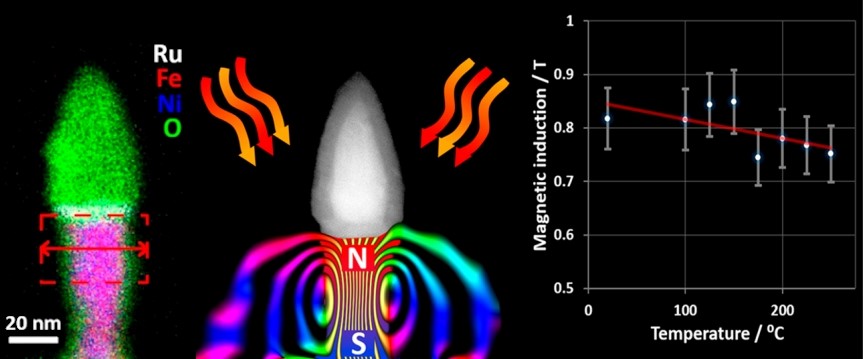Perpendicular-shape-anisotropy magnetic random-access memory (PSA MRAM) has been proposed to maintain the thermal stability of solid-state magnetic bits down to a few nanometers in diameter. Here we confirm directly with high-spatial resolution and high-sensitivity electron holography that magnetization is weakly affected by temperature, in contrast with the conventional ultrathin MRAM cells.
Magnetic random-access memory (MRAM) is an emerging class of solid-state memory. It is non-volatile, boasts orders of magnitude larger endurance than flash, and has a good compromise between write energy and time, typically a few nJ and a few ns. Based on these assets, MRAM is now used commercially in microcontrollers or as cache memory. Expanding the use of MRAM for the automotive industry or for high-density memories such as DRAM, requires to enhance their thermal stability down to advanced technological nodes. Standard MRAMs face their limits here, as their ultrathin storage layers are very sensitive to thermal energy, so that even at room temperature memory cells below 20nm in diameter lose long-term retention. In 2018 SPINTEC and Tohoku University proposed independently the concept of perpendicular-shape-anisotropy MRAM, in which the storage layer is a vertical nanopillar, enhancing its thermal stability via a dipolar shape effect and a large volume. While electric measurements have confirmed the ability to operate such sub-10nm MRAM cells, information on their enhanced thermal stability is only inferred indirectly.
Here, we have used off-axis electron holography to monitor the thermal dependence of the magnetization state and the spontaneous magnetization in a sub-20nm FeNi nanopillar, such as used for the storage layer in a PSA-MRAM cell. This technic is ideally suited for that purpose, combining high spatial resolution, direct and quantitative information about magnetization, and fully compatible with variable temperature. We showed that the magnetization state is very close to uniform, perpendicular and symmetric. Besides, we measured directly that magnetization is very weakly decaying with temperature, no more than in the bulk material, in sharp contrast with the ultrathin storage layers implemented in standard MRAM cells.

(left) Chemical map of a perpendicular-shape-anisotropy free layer (pink part) (center) Colored iso-phase lines in electron holography, indicative of magnetic induction lines. This highlights magnetization in the pillar, and the stray field outside (right) Minute decrease of magnetic induction with temperature.
Our results confirm the relevance of PSA MRAM for demanding applications, such as automotive or high-density memories. Our results have been made possible by combining several methodology developments, such as a specific preparation of lamella to reduce non-magnetic artefacts, registered acquisition of image stacks to improve signal-to-noise ratio, and disentangling magnetization from the demagnetizing and stray fields to provide accurate figures for magnetization. We believe that these developments will be useful for a variety of nanosized magnetic elements.
Teams: MRAM, Spin Textures, Instrumentation
Collaboration: CEA-LETI, PTA, PFNC
Funding: ERC Magical, ANR RTB
Further reading: Quantitative Visualization of Thermally Enhanced Perpendicular Shape Anisotropy STT-MRAM Nanopillars, T. P. Almeida et al., Nano. Lett. 22, 4000 (2022). Open access: hal-03553914v2
Contacts: Aurelien Masseboeuf, Bernard Dieny, Olivier Fruchart




